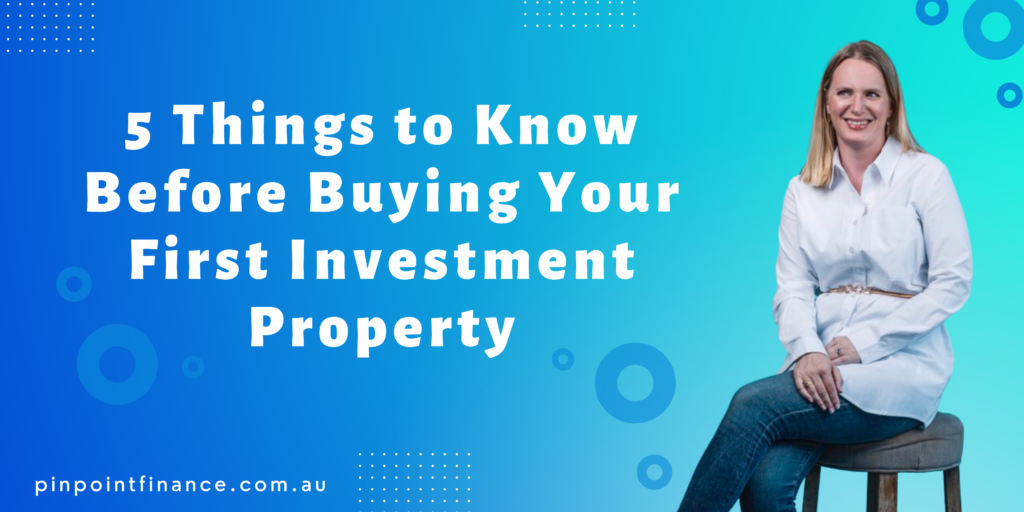Investment properties in Australia are a great way of building long-term wealth, but jumping into property investment requires more than just ambition. As you know there’s a lot to consider, from understanding how much you can borrow, to choosing the right location, and understanding where the market is in the property cycle for the locations you’re interested in. This is why learning a little more to know to avoid common pitfalls, make confident decisions, and get started on the right foot with your first investment property is so important.
Let’s dive in.

1. Understand How Property Investment Works
Property investment isn’t a shortcut to overnight riches. It’s a steady, long-term approach to building wealth that typically involves buying a property, renting it out, and watching its value (hopefully) rise over time. To make it work, you’ll need to understand market dynamics, manage tenants, and keep up with property maintenance. The payoff can be substantial if you’re ready to commit for the long haul, but it takes a clear strategy and plenty of patience.
The basic model? Buy a property, rent it out, and let your equity grow over time. You’ll need to juggle market fluctuations, tenant management, and maintenance costs, but if you get it right, property investment can be a solid foundation for long-term wealth.
2. Financing and the Purchase Process
Securing financing is one of the first big steps in property investment. Most first-time investors will either take out a new mortgage or use the equity in their existing property to fund the purchase. Here are some key steps:
- Evaluate Your Financial Position: Assess your finances to ensure you can handle the initial deposit, stamp duty, and ongoing mortgage repayments.
- Understand Loan Options: There’s a range of loans available, from interest-only to principal and interest loans. Choose a structure that aligns with your investment goals and cash flow needs.
- Get Pre-Approval: Pre-approval from your lender can give you a better idea of what you can afford and put you in a stronger position to negotiate.
Having the right mortgage can make or break your investment success. Consulting with a mortgage broker who understands the needs of property investors can save you time, reduce stress, and often unlock more suitable financing options.
3. Choosing the Right Investment Property
Not all properties make good investments. Choosing the right one requires research, foresight, and a bit of know-how. Here are some essentials:
- Location, Location, Location: Look for areas with growth potential, like up-and-coming suburbs or neighbourhoods near good schools, public transport, and amenities. These factors can increase both rental yield and long-term capital growth.
- Property Type: Whether it’s a house, an apartment, or a townhouse, each type of property has its own benefits and drawbacks. Houses often provide stronger capital growth, while apartments and townhouses tend to offer higher rental yields. Be sure the type of property aligns with your budget and investment goals.
- Property Condition: Sometimes, properties needing a bit of TLC offer the best opportunities. However, renovations can come with significant costs, so budget wisely and only take on what you’re comfortable managing.
To minimise risk and make a strong start, pick a property that matches your budget, aligns with your goals, and is in a desirable area with potential for growth.
4. Decide Between Capital Growth and Cash Flow
In property investment, there are two main strategies: capital growth and cash flow. Choosing one—or a balance between both—depends on your goals and investment strategy.
- Capital Growth: This approach is about buying in areas where property values are expected to increase significantly over time. If you’re in it for the long term and don’t mind waiting, capital growth can yield substantial returns.
- Cash Flow: This strategy focuses on properties with high rental yields that generate consistent income. Cash flow properties might not appreciate as much in value, but they provide regular income, which can be beneficial for covering expenses and creating a financial buffer.
Many investors aim to strike a balance, achieving some rental income while also holding out for long-term growth. Your goals, financial situation, and risk tolerance will guide which strategy is best for you.
5. Know the Market Cycles: Timing Is Everything
The property market moves in cycles, and understanding these phases can make a big difference in your investment success.
- Boom: Property prices rise rapidly as demand outstrips supply. Although tempting, buying during a boom often means paying a premium, so caution is essential.
- Decline: Prices start to drop as demand slows. For a savvy buyer, this phase can offer bargain opportunities, but it’s essential to avoid areas with long-term decline risks.
- Stabilisation: The market levels off, prices stop dropping, and rents stabilise. This is often a great time to buy as the market is less volatile.
- Recovery: Prices begin to rise again, offering growth opportunities for those who bought during the decline or stabilisation phases.
Navigating market cycles successfully takes patience and discipline. Avoid panic during downturns, stay cautious during booms, and take a long-term view. With careful planning, you can make the cycles work in your favour to build real long term wealth for you and your family.
